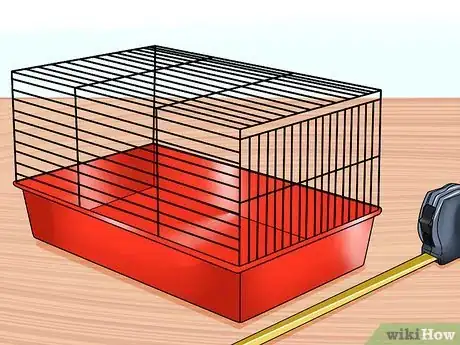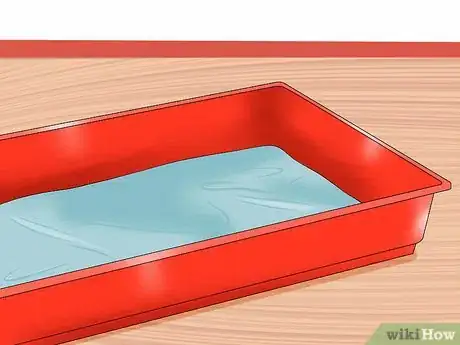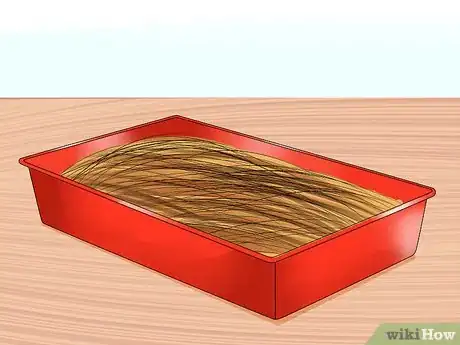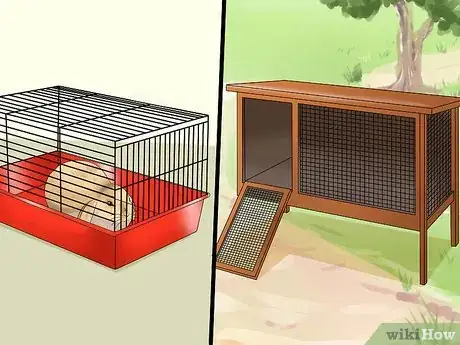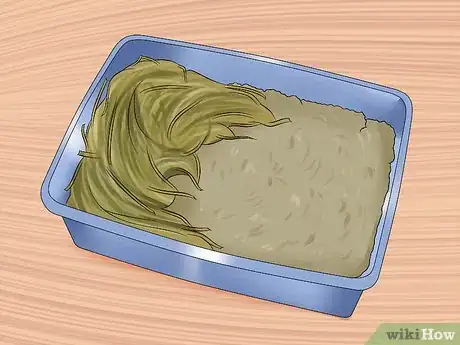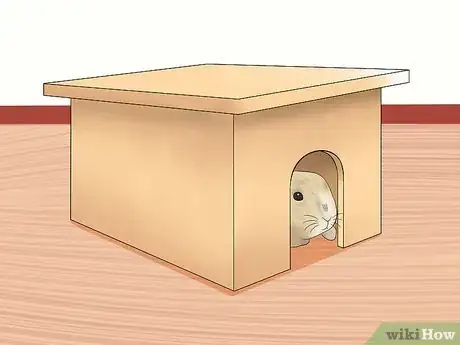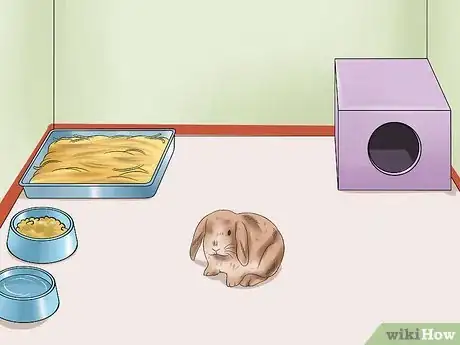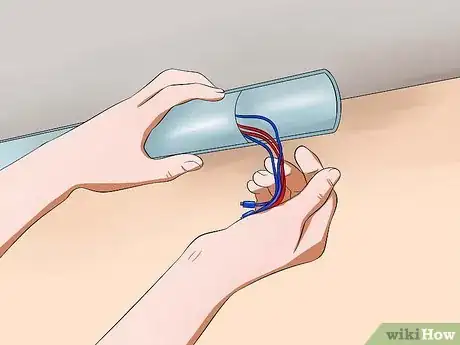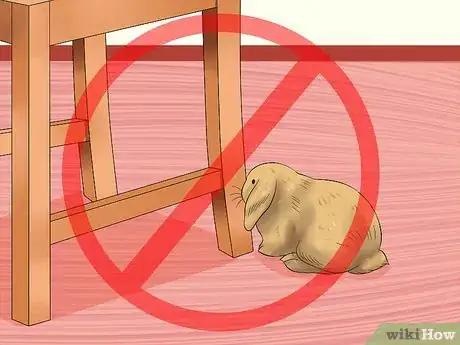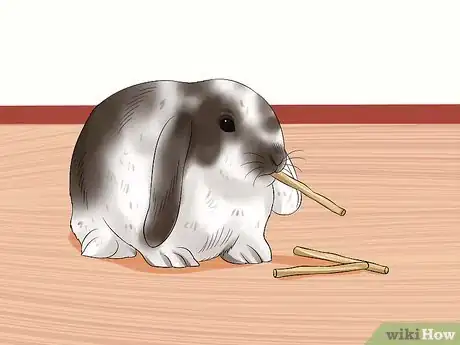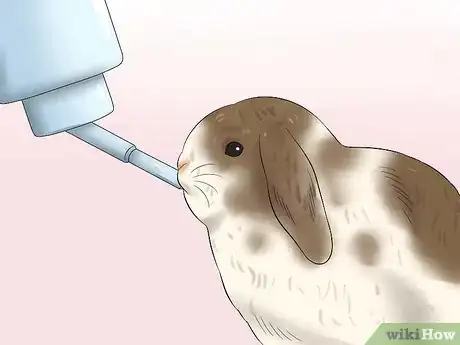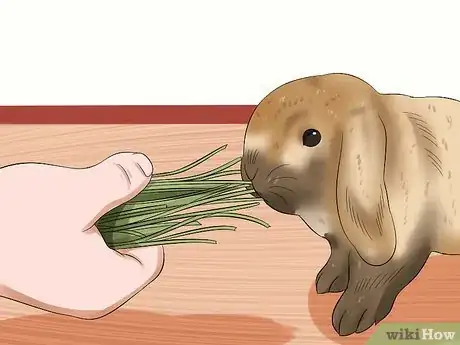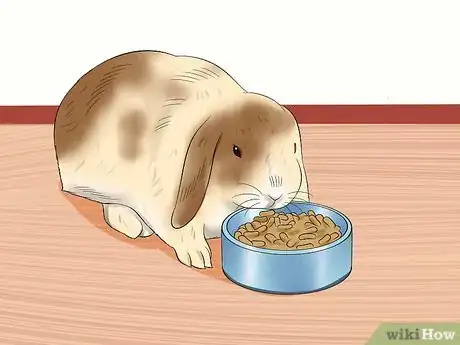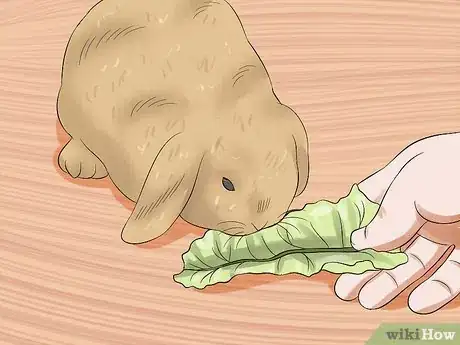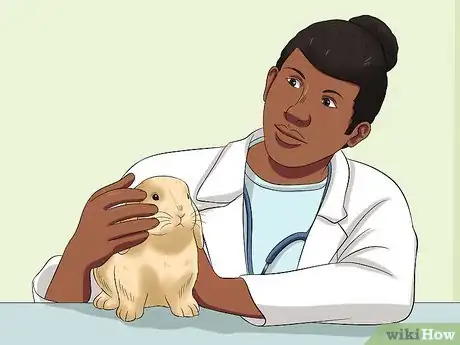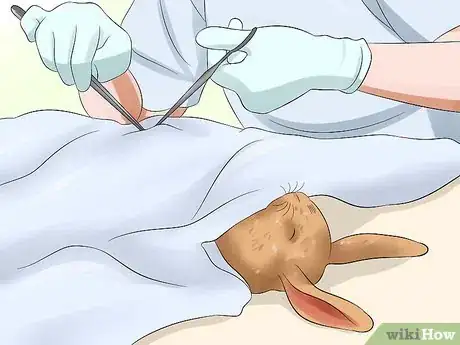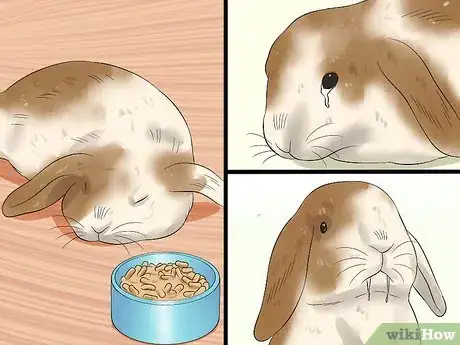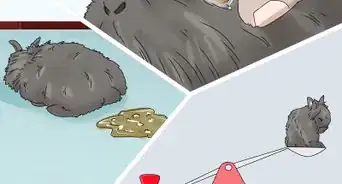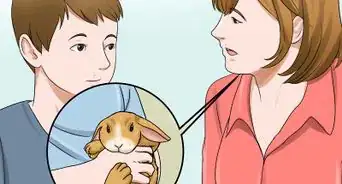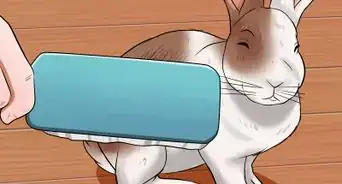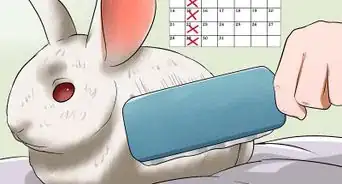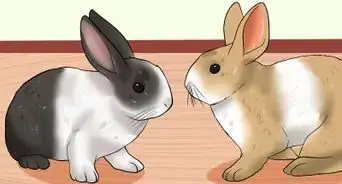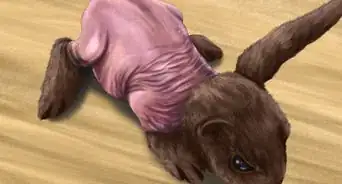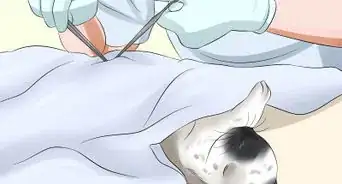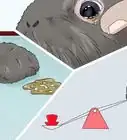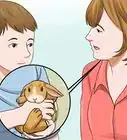This article was co-authored by Pippa Elliott, MRCVS. Dr. Elliott, BVMS, MRCVS is a veterinarian with over 30 years of experience in veterinary surgery and companion animal practice. She graduated from the University of Glasgow in 1987 with a degree in veterinary medicine and surgery. She has worked at the same animal clinic in her hometown for over 20 years.
wikiHow marks an article as reader-approved once it receives enough positive feedback. In this case, 88% of readers who voted found the article helpful, earning it our reader-approved status.
This article has been viewed 131,379 times.
Holland Lop rabbits are the epitome of cuteness with their compact size and droopy ears. They are a small breed of rabbit only weighing between three to four pounds when fully grown. If you learn how to take care of your Holland Lop bunny properly, your bunny can lead a happy and healthy life in your home.
Steps
Making a Home For Your Rabbit
-
1Set up a bunny cage. Prior to bringing your Holland Lop rabbit home, you will want to set up a cage for him or her. Look for a cage with a minimum size of one square foot per pound of full grown rabbit. For a Holland Lop rabbit, that is at least a four foot square cage. They are very active, so make sure your rabbit has plenty of run to run around.The width should be one and a half times the length of the fully grown rabbit, while the cage length should be three times the length of the bunny. For example, if the rabbit is 12 inches (30.5 cm) long, the width should be 18 inches (45.7 cm) and the length should be 36 inches (91.4 cm). That is the room just for the rabbit itself.
- You will want it to also have room for a litter box with litter, her food and water dishes, and a box for her to rest in, so aim for at least twice that amount of floor space in the cage.
-
2Get a cage with a solid floor. Make sure to give the bunny a cage with a solid floor instead of a wire floor. Wire floors can cause sores on the bottom of your rabbit’s feet, and small rabbits such as the Holland Lop can get their feet stuck and get injured. Place a piece of carpeting or wooden flooring along the bottom of the cage.
- You can also use a piece of fleece fabric, because it won’t leave long strings in the digestive tract if the rabbit eats it.
- You can also put newspaper under the cage, just don’t use newspaper as bedding.[1]
- Keep in mind that you will also need to place a layer of bedding over the floor to provide cushioning for the bunny.
Advertisement -
3Add bedding to the cage. The cage needs bedding even if the floor is solid. The bedding will act as your rabbit’s sleeping area. The bedding should be edible, since your rabbit will eat it. Meadow or timothy hay, natural fiber blanket, pelleted paper, or other organic products make good bedding materials.
- Make sure to give her enough so she can shape it, move it, and burrow in it how she wants.
- Check the bedding daily and clean as necessary. Your rabbit shouldn’t be going to the bathroom in the bedding, so if this occurs, you need to give the rabbit a larger area to roam, exercise, and move around. Unclean bedding can lead to fleas, flies, and other pests.
- Don’t use straw, cardboard, newspaper, wood shavings, sawdust, cat litter, or cedar or pine products as bedding. It can harm your rabbit.
-
4Decide if you want your rabbit cage indoors or outdoors. There are advantages to either habitat. Rabbits that live indoors usually have longer lives and are happier and more social. Rabbits that live outdoors are skittish, susceptible to temperature and weather changes, predators, mites, flies, fleas, and other complications.
- If you want to keep your rabbit inside, but have limited space for her to play, you can set up an outdoor cage for her to run around and play.
- Outdoor hutches are easier to clean and give the rabbit more room to play and run around. If you play your hutch outside, make sure to keep it away from direct sunlight, drafts, damp areas, humidity, extreme temperatures, or loud noises. The hutch should have a roof to protect her from the rain. Make sure the hutch is protected from predators, including dogs and cats.
-
5Provide a litter box. Place a box inside your bunny’s cage to act as a litter box. For a small Holland lop rabbit, a medium sized plastic cat litter pan will be sufficient. It is better to get a bigger litter box than a smaller box. Inside the litter box, place fresh hay. You can also place bunny-safe pet bedding under the hay.[2]
- Make a kitchen end and a bathroom end of the box. The bathroom end will be where they do their business, while the kitchen end will be where they will nibble clean hay.
- If you have multiple bunnies, get a very large litter box or individual boxes for each bunny.
- Change your bunny’s hay often to keep it clean. Bunny’s will use a clean litter box, but avoid a dirty one. Don’t go 2 days without changing the litter box. To clean, just dump everything into the trash, add more bunny-safe bedding, and wash the box.
- You should confine him to this cage until he is consistently using the litter box.
-
6Set up a hiding place. Rabbits are naturally skittish and like to hide from predators, loud noises, or other things that scare them. You need to provide hiding places for your rabbits, such as a cardboard box, a system of tunnels made out of cardboard tubes, or a low enclosed area easily accessible. You can also purchase rabbit hiding places from the pet store.[3]
Rabbit-proofing Your Home
-
1Consider giving your rabbit an indoor room. If you keep your rabbit inside, you can choose one room to let your bunny run around in. This room should have a litter box, a hay feeder, food dishes, and water bowl in one area. Place a mat under it to protect it from messes. Inside the room, you can set up cardboard castles, bunny condos, puppy pens, or rabbit cages.[4]
-
2Cover or remove electrical wiring. Rabbits chew constantly. If you are going to let your bunny run around a room, you need to protect your bunny by covering up wires or removing them. Hide and protect electrical cords with hard plastic tubing split lengthwise with the cords tucked inside inside. You can also tuck cords behind wood work or trim, wrap them in spiral wrap, or use concealers to keep them out of sight.[5]
-
3Protect trim and furniture from chewing. Rabbits will chew on trim, door edges, and furniture legs. They may also chew wallpaper, sheetrock, and carpet. Place a board over any places that your bunny may want to chew. Place cardboard or 2x4s under furniture so the rabbit doesn’t burrow up into the soft underside of it. You can also place clear plastic panels over the wall to keep the rabbit from chewing on it.[6]
- Watch your bunny carefully when she is running around the room and give her an acceptable chewing object if she tries to go after furniture or part of the house.
-
4Keep out plenty of acceptable things for your rabbit to chew. To help deter your rabbit from chewing things she shouldn’t, you should provide plenty of things for the rabbit to chew on. These include alfalfa cubes, grass hay stuffed in cardboard tubes, fresh branches (apple, willow or aspen only), or rolled up cotton towels.
Feeding Your Rabbit
-
1Place a water dish in the cage. You can use a sipper bottle or a ceramic dish for a water dish. While a sipper bottle will be easier to keep clean, rabbits seem to prefer drinking out of ceramic dishes.[7]
- If you let your rabbit run around in a room, make sure there is plenty water available for her.
-
2Give your rabbit hay. Rabbits need the correct amount of fiber each day, along with moisture, to maintain a healthy gut. If not, they can suffer ill health and may even die. One of the mainstays of a Holland Lop’s diet is a high quality grass hay.Grass hay should be fed in unlimited amounts. Make sure to toss any spoiled or wet hay in the garbage and give your Holland Lop fresh hay daily.
- Grass hay is better for a rabbit than alfalfa hay, which is too high in protein and calcium to be fed as anything other than as a treat.
-
3Provide your rabbit with pellets. Another staple of a rabbit’s diet is a commercial rabbit pellet. This is better than grain or seed mixes as it is properly formulated for a bunny to provide all nutrients they need. If a bunny has a seed or grain mix, she will pick out the parts she likes and leave behind those she doesn’t, leaving his or her diet unbalanced.
- An adult Holland Lop rabbit can have ⅛ to ¼ cup of pellets daily.
- Make sure to change the pellets daily so your rabbit can have fresh pellets.
-
4Feed your rabbit greens. Green leafy vegetables are needed to provide fiber and moisture to the diet. Good choices are all kinds of lettuce, except iceberg which is nutritionally deficient, bok choy, broccoli stems and leaves, carrot tops, and dandelion greens. Only feed your Holland Lop ½ to 1 loose cup of these a day.
-
5Give your bunny treats. Bunnies can have starchy vegetables, like carrot roots, and fresh fruit, but only a few tablespoons a day. Never feed any other human foods to rabbits, nor corn or other grains. Stick to hay, pellets, and leafy vegetables as the majority of the bunny’s diet.
Taking Care of Your Rabbit
-
1Take your rabbit to the vet. Most Holland Lop rabbits are healthy as long as a proper diet is fed to them. However, once a year she needs a veterinarian examination to make sure all is well. This examination will include a tooth check to make sure the teeth are wearing properly. If not, the veterinarian may need to trim them so the mouth or teeth don’t become injured.
-
2Spay or neuter your rabbit. Your bunny should be neutered if he is a male or spayed if she is a female when he or she is 4 to 6 months of age. This stops unwanted litters if you have two rabbits of the opposite sex, plus stops bad behaviors like aggression or urine spraying. It also eliminates reproductive system cancer and infections.[8]
-
3Watch out for signs of illness. For the most part, rabbits with proper diets are healthy. However, you should be aware of the signs of illness, which include refusing to eat or drink, diarrhea, not pooping for a day, eye or nasal discharge, drooling, swellings, reddened skin, or fur loss anywhere on the body, not hopping or moving like normal or unable to use back legs, dark, red urine, or a fever of more than 105 °F (41 °C).
- Never ignore these signs. If you see them, contact your veterinarian immediately for an examination.
Expert Q&A
Did you know you can get expert answers for this article?
Unlock expert answers by supporting wikiHow
-
QuestionAre rabbits okay on their own?
 Melissa Nelson, DVM, PhDDr. Nelson is a Veterinarian who specializes in Companion and Large Animal Medicine in Minnesota, where she has over 18 years of experience as a veterinarian in a rural clinic. She received her Doctor of Veterinary Medicine from the University of Minnesota in 1998.
Melissa Nelson, DVM, PhDDr. Nelson is a Veterinarian who specializes in Companion and Large Animal Medicine in Minnesota, where she has over 18 years of experience as a veterinarian in a rural clinic. She received her Doctor of Veterinary Medicine from the University of Minnesota in 1998.
Veterinarian
-
QuestionHow long do Holland lop ear rabbits live?
 Melissa Nelson, DVM, PhDDr. Nelson is a Veterinarian who specializes in Companion and Large Animal Medicine in Minnesota, where she has over 18 years of experience as a veterinarian in a rural clinic. She received her Doctor of Veterinary Medicine from the University of Minnesota in 1998.
Melissa Nelson, DVM, PhDDr. Nelson is a Veterinarian who specializes in Companion and Large Animal Medicine in Minnesota, where she has over 18 years of experience as a veterinarian in a rural clinic. She received her Doctor of Veterinary Medicine from the University of Minnesota in 1998.
Veterinarian
-
QuestionAre mini lop rabbits good pets?
 Melissa Nelson, DVM, PhDDr. Nelson is a Veterinarian who specializes in Companion and Large Animal Medicine in Minnesota, where she has over 18 years of experience as a veterinarian in a rural clinic. She received her Doctor of Veterinary Medicine from the University of Minnesota in 1998.
Melissa Nelson, DVM, PhDDr. Nelson is a Veterinarian who specializes in Companion and Large Animal Medicine in Minnesota, where she has over 18 years of experience as a veterinarian in a rural clinic. She received her Doctor of Veterinary Medicine from the University of Minnesota in 1998.
Veterinarian
Warnings
- Rabbits will kick hard, when they are picked up incorrectly and run the risk of breaking their backs this way. Scoop your rabbit up from the rear with one hand while the other is under the chest.⧼thumbs_response⧽
- When you feed a new food, leafy greens, or vegetable/fruit to your bunny, go slowly with introducing the food. Only a few pieces a day to make sure you don’t give them an upset tummy.⧼thumbs_response⧽
- Rabbits normally produce soft stools at night that they then eat to help their digestive system. It isn’t diarrhea and is perfectly healthy for the rabbit, so don’t worry.⧼thumbs_response⧽
References
- ↑ http://support.michiganhumane.org/site/PageServer?pagename=vetcare_rabbits
- ↑ http://myhouserabbit.com/rabbit-care/housing-your-pet-rabbit-indoors/
- ↑ http://www.therabbithouse.com/equipment/rabbit-hideaways.asp
- ↑ http://myhouserabbit.com/rabbit-care/housing-your-pet-rabbit-indoors/
- ↑ http://rabbit.org/faq-rabbit-proofing/
- ↑ http://rabbit.org/faq-rabbit-proofing/
- ↑ http://support.michiganhumane.org/site/PageServer?pagename=vetcare_rabbits
- ↑ http://rabbit.org/faq-spaying-and-neutering/
About This Article
To care for your Holland Lop rabbit, set it up in a cage that’s big enough for it to run around in, with extra space for its food, water, bed, and litter box. Additionally, provide your pet with rabbit pellets and greens, like bok choy and broccoli leaves, to meet its daily nutritional needs. You’ll also need to take your pet to the vet’s once a year to make sure it’s healthy and that its teeth are wearing properly. For more information from our Veterinary co-author, including how to make the inside of your home safe for your rabbit, read on!
